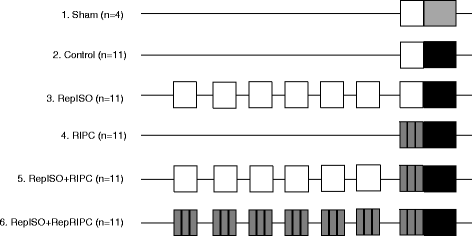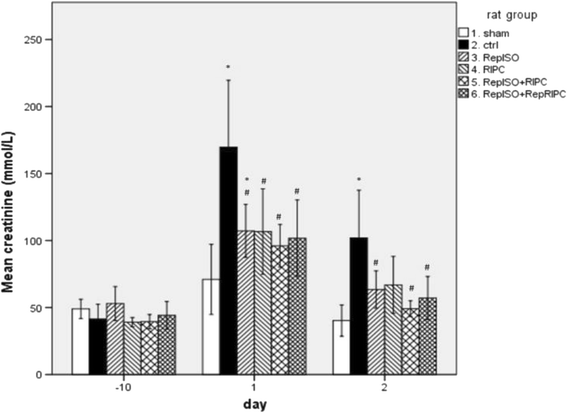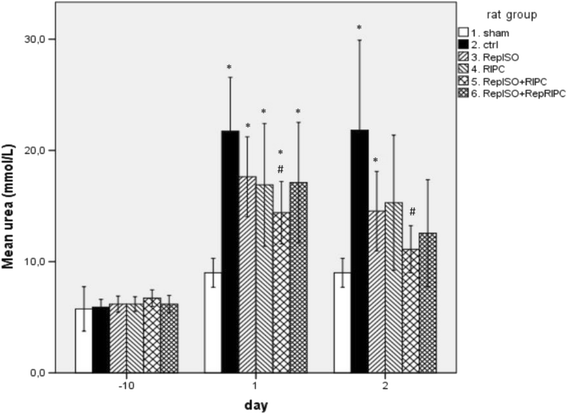Repeated remote ischemic preconditioning and isoflurane anesthesia in an experimental model of renal ischemia-reperfusion injury
- PMID: 28129737
- PMCID: PMC5273799
- DOI: 10.1186/s12871-017-0310-x
Repeated remote ischemic preconditioning and isoflurane anesthesia in an experimental model of renal ischemia-reperfusion injury
Abstract
Background: In animal studies, remote ischemic preconditioning (RIPC) and anesthetic preconditioning are successful in reducing renal ischemia reperfusion injury (IRI), however the protective effect of RIPC may be improved by repeating the RIPC stimulus.
Methods: Sprague-Dawley rats underwent unilateral nephrectomy followed by 30 min of renal pedicle clamping. Animals were allocated into six groups: sham, control (IRI), RepISO (daily isoflurane anesthesia), RIPC (single dose isoflurane anesthesia and single dose RIPC), RepISO + RIPC (7-day isoflurane anesthesia and single dose RIPC) and RepISO + RepRIPC (7-day isoflurane anesthesia with 7-day RIPC). RIPC was applied by 3×5 min of cuff inflation on both thighs. Serum creatinine and urea levels were measured and histology was obtained at day two.
Results: RepISO diminished renal IRI, as reflected by a significant reduction in serum creatinine levels as compared to the control group, 170 ± 74 resp. 107 ± 29 μmol/L. The other preconditioning protocols showed similar reduction in serum creatinine levels as compared to the control group. No significant differences were observed between the different preconditioning protocols. For urea levels, only RepISO + RIPC resulted in significantly lower levels as compared to the control group, 14 ± 4 resp. 22 ± 7 mmol/L (p = 0.010). In the preconditioning groups only RepISO showed less histological damage as compared to controls 1.73 ± 1.19 resp. 2.91 ± 1.22 (p = 0.032).
Conclusions: In this study no additional protective effect of repeated ischemic preconditioning was observed as compared to single dose RIPC. Repeated administration of isoflurane provided stronger protection against renal IRI as compared to single dose isoflurane.
Keywords: Anesthetic preconditioning; Animal experiment; Ischemia reperfusion injury; Kidney; Repeated remote ischemic preconditioning.
Figures




Similar articles
-
Remote Ischemic Preconditioning Decreases the Magnitude of Hepatic Ischemia-Reperfusion Injury on a Swine Model of Supraceliac Aortic Cross-Clamping.Ann Vasc Surg. 2018 Apr;48:241-250. doi: 10.1016/j.avsg.2017.08.006. Epub 2017 Sep 6. Ann Vasc Surg. 2018. PMID: 28887256
-
Effects of ischemic preconditioning protocols on skeletal muscle ischemia-reperfusion injury.J Surg Res. 2015 Feb;193(2):942-52. doi: 10.1016/j.jss.2014.09.032. Epub 2014 Sep 30. J Surg Res. 2015. PMID: 25438960
-
Remote Ischemic Preconditioning May Attenuate Renal Ischemia-Reperfusion Injury in a Porcine Model of Supraceliac Aortic Cross-Clamping.J Vasc Res. 2015;52(3):161-71. doi: 10.1159/000439219. Epub 2015 Oct 20. J Vasc Res. 2015. PMID: 26745363
-
Remote ischemic preconditioning: a novel protective method from ischemia reperfusion injury--a review.J Surg Res. 2008 Dec;150(2):304-30. doi: 10.1016/j.jss.2007.12.747. Epub 2008 Jan 22. J Surg Res. 2008. PMID: 19040966 Review.
-
Protocols and mechanisms for remote ischemic preconditioning: a novel method for reducing ischemia reperfusion injury.Transplantation. 2007 Aug 27;84(4):445-58. doi: 10.1097/01.tp.0000228235.55419.e8. Transplantation. 2007. PMID: 17713425 Review.
Cited by
-
Mas Receptor Blockade Promotes Renal Vascular Response to Ang II after Partial Kidney Ischemia/Reperfusion in a Two-Kidney-One-Clip Hypertensive Rats Model.Int J Nephrol. 2021 Apr 20;2021:6618061. doi: 10.1155/2021/6618061. eCollection 2021. Int J Nephrol. 2021. PMID: 33986960 Free PMC article.
-
Rodent models of AKI-CKD transition.Am J Physiol Renal Physiol. 2018 Oct 1;315(4):F1098-F1106. doi: 10.1152/ajprenal.00199.2018. Epub 2018 Jun 27. Am J Physiol Renal Physiol. 2018. PMID: 29949392 Free PMC article. Review.
-
Rodent models of AKI and AKI-CKD transition: an update in 2024.Am J Physiol Renal Physiol. 2024 Apr 1;326(4):F563-F583. doi: 10.1152/ajprenal.00402.2023. Epub 2024 Feb 1. Am J Physiol Renal Physiol. 2024. PMID: 38299215 Free PMC article. Review.
-
Protective effects of celecoxib on ischemia reperfusion-induced acute kidney injury: comparing between male and female rats.Iran J Basic Med Sci. 2019 Jan;22(1):43-48. doi: 10.22038/ijbms.2018.29644.7156. Iran J Basic Med Sci. 2019. PMID: 30944707 Free PMC article.
-
Protection of multiple ischemic organs by controlled reperfusion.Brain Circ. 2021 Dec 21;7(4):241-246. doi: 10.4103/bc.bc_59_21. eCollection 2021 Oct-Dec. Brain Circ. 2021. PMID: 35071839 Free PMC article. Review.
References
MeSH terms
Substances
LinkOut - more resources
Full Text Sources
Other Literature Sources

